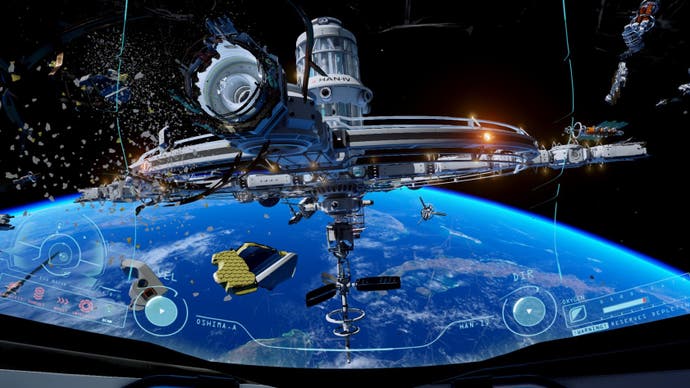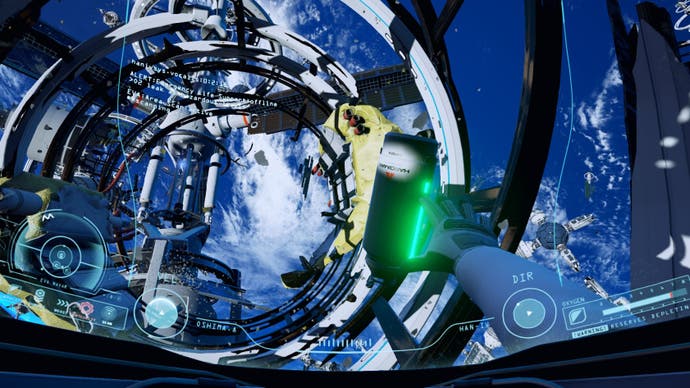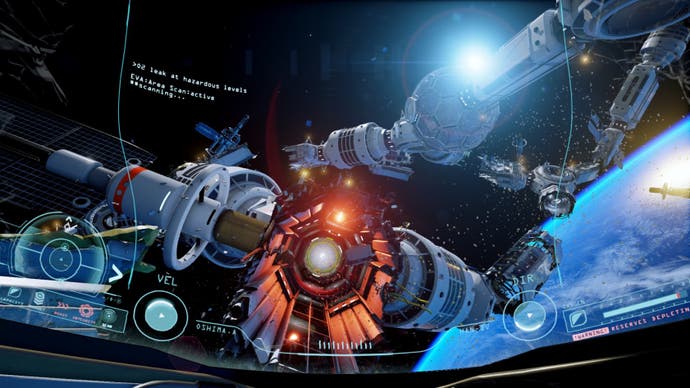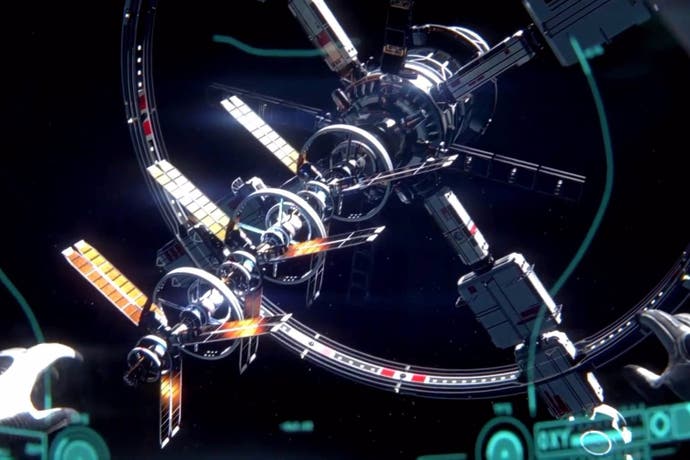Adr1ft review
Re-entry level.
When Adr1ft was announced at the end of 2014, the initial reports immediately compared it to Alfonso Cuarón's spatially dazzling thriller Gravity. At first glance this is not an unfair comparison. Both are near-future space adventures which are aesthetically similar, blending the deep black of space with the harsh whites of human endeavour and dramatic views of Earth in orbit. Moreover, both have become flagships for 3D, with Gravity helping to sell plastic glasses for cinemas and Adr1ft helping to sell plastic boxes for Oculus.
But if you arrive at Adr1ft anticipating thrills, spills and Sandra Bullock, you're likely to leave disappointed. In many ways Adr1ft is an anti-Gravity, a slower and more thoughtful affair for which the closest equivalent of an action-sequence is when you narrowly miss grabbing a passing O2 canister. I'd like to say this makes it a more fulfilling, intellectually satisfying experience. But if I'm being perfectly honest, I much preferred Dr. Ryan Stone whizzing around space with a fire-extinguisher.
Sadly, Adr1ft is not a very good game. It is a tremendous achievement in environment design, making use of 3D space in a way that few games do. It also has a couple of neat ideas, and the story which is scrappily tells is, overall, a decent one. But it's interactively barren and somehow manages to turn one of the most desperate survival situations imaginable into a monotonous routine.
It also begins on a flat note. Adr1ft slips you into the spacesuit of Alex Oshima, Commander of the Han IV space station, who awakes in her EVA suit to find herself floating in open space with pieces of Han IV scattered all around her. That's right, Adr1ft begins immediately after the disaster has occurred. Not only does this mean Adr1ft effectively starts on an anticlimax, it also means there's no frame of reference for what the station looked like originally.

Instead the danger of space is conveyed on a much smaller scale, Oshima's EVA suit is damaged and leaking O2, which leaks even faster when she uses her propulsion jets to move around space. This is ADR1FT's central mechanic, the stuff you need to breathe is also the stuff you need to move around. Hence you must limit yourself to quick directional adjustments letting inertia do the work for you, while replenishing your O2 supply wherever possible, primarily via the abundant O2 canisters floating amid the wreckage.
Obviously the idea is to create tension by using the same resource for two different jobs, but because it's so easy to keep your supply refilled, you're only likely to run out of oxygen early on, or if you go completely in the wrong direction. Despite not having the desired effect, O2 supply still requires your constant attention. What results is the "minimap" problem, whereby you're distracted from what's happening on the main-screen because you're constantly glancing at your O2 meter in the corner.
In addition to O2, you also need to watch the integrity of your suit. Even a slight collision into another object will cause cracks to appear on your spacesuit's visor, and eventually the damage will compromise the suit's other systems. Although a secondary concern theoretically, keeping your suit intact is actually a far greater challenge than ensuring your O2 is in good supply. Floating around in the cramped corridors of the station without bumping into anything is genuinely tricky, as every adjustment alters both your direction and momentum.
At times playing Adr1ft is akin to a big-budget version of one of those buzzing wire games you find in a fairground, only here if you touch the wire you're sucked inside-out by an infinite vacuum. The only problem is the sense of impact when you do hit something is underwhelming, and it's difficult to tell exactly how damaged your suit is. Adr1ft is also surprisingly reluctant to throw genuine environmental challenges your way. From time to time you'll have to weave through the spinning solar panels of a satellite array, or a section of station electrified by loose wires, but otherwise the game is content to keep active hazards few and far between.

So Adrift is not a particularly gripping survival experience. What it does extremely well is representing space as a 3D environment that feels confusing and disorienting without actually being confusing and disorienting. Han IV has shattered into dozens of different pieces, which are all located around a central hub that is still largely intact. Some bits are upside down while others float hundreds of feet above or below the hub. But the designers cleverly use the debris scattered between the larger chunks to hint at the appropriate paths you need to travel. Adr1ft constantly messes with your perspective, but it rarely lets you become completely lost.
Unfortunately, while the environmental design is fascinating, what you actually do in this environment is not. The main objective is to repair four mainframe computers scattered at the far corners of the station, in order to activate the escape shuttle and travel safely back to Earth. But this rigid formatting of the overall structure results in a game that runs out of surprises by the halfway point. There are no twists that are likely to grab your attention, the situation never improves or deteriorates or fluctuates between both. The entire experience is weirdly mundane, which given it is about the most extreme survival situation possible, is almost an achievement.
What doesn't help is that the story is all backstory, the audio logs, emails and recorded transmissions are all about what happened prior to the disaster. They're well written and acted, and the gradually unfolding story about why the station fell apart, who is responsible, is certainly intriguing, but there's no current-events dialogue, no back-and-forth between Oshima and mission control that might give the player something to get their teeth into from moment to moment, as Firewatch demonstrated so recently and so effectively.
There are also some bizarre character inconsistencies that simply don't fit with the situation. We're repeatedly told how important it is that protocol is followed to the letter on the station, how everything must be atomically precise and exact as part of Han IV's mission to make a Lunar colony a viable prospect. And yet, one of your crewmates is a recovering drug addict, one who, apparently, used to steal supplies from the hospital he worked at to feed his addiction.

Given that Adr1ft is pitched to us as a realistic, near-future science-fiction, I find it difficult to believe that any spacefaring organisation, be it NASA or a private company like the game's Hardiman Aerospace, is going to knowingly hire someone with a recorded history of substance abuse for a job that high-risk, which requires such incredible psychological fortitude to manage the loneliness and isolation. Another crewmember has cancer, apparently, although it isn't made clear whether that happened before or after mission-start, so maybe that makes sense? I can understand if Three One Zero was concerned about the game feeling impersonal, but in the context of the fiction these particular character attributes simply don't gel.
In the scheme of things, this is a fairly small flaw that happened to really bug me. A much bigger issue, indeed the largest of all Adr1ft's problems, is that there is almost no physical engagement with the world. Virtually every action is performed by pressing F. Press F to pick up O2 canister, press F to open door, press F to input highly complex command line in order to reboot computer mainframe. It isn't simply that there isn't much for the player to do, it's that the few actions which are available are all funnelled into the same context-sensitive system, meaning you're one-step removed from any action that Oshima performs.
In a game that largely consists of floating around avoiding contact, where there are extended periods of time in which you don't need to touch the controls at all, the importance of a sense of tactility when you can get hands on with something is paramount. Adr1ft is in dire need of a physical system like those seen in Frictional's horror games, where every dial, switch, lever, button and so forth can be interacted with individually and in detail. (As a brief aside, every single developer of non-combative first-person adventures should be looking at Frictional as an example of how to make first-person interesting once you take the guns away).
Adr1ft fails to do this, and the result is a game that is both distant and cold. The narrative lacks urgency and the game itself lacks direction or interactive immediacy. It remains a treat for the eyes, and no doubt an impressive technical showcase of what VR can achieve, but while Adr1ft might make your head spin, it's unlikely to make your heart race.

